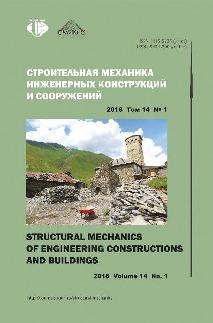FEASIBLITY EVALUATION FOR A PREDEFINED SEISMIC RESISTANCE OF STRUCTURES
- Authors: DZHINCHVELASHVILI G.A1, BULUSHEV S.V2
-
Affiliations:
- Russian University of Transport, Moscow, Russian Federation
- Moscow State University of Civil Engineering (National Research University), Moscow, Russian Federation
- Issue: Vol 14, No 1 (2018)
- Pages: 70-79
- Section: Seismic resistence
- URL: https://journals.rudn.ru/structural-mechanics/article/view/17797
- DOI: https://doi.org/10.22363/1815-5235-2018-14-1-70-79
Cite item
Full Text
Abstract
Nowadays seismic resistant structural design is based on force analysis and on representing the earthquake effect as equivalent static forces set as elastic response spectra (response spectrum method). These response spectra link the law of earth motion to the absolute acceleration of the structure's model. This approach takes no account of either the effect of intense motion duration or of the plastic behavior of the structure. The frequency content and the duration of earth oscillations immediately influence the energy taken in by the building and causing damage to its elements. In theoretical terms, the input energy depends on the model of the structure in question. The input energy is determined by a dynamic calculation for the selected model or by theoretical assessment. Then, the energy is compared to the energy capacity, i.e. maximum energy which can be conveyed to the building before it collapses. Conventionally, the energy capacity is compared to the plastic component of the input energy (absorbed by the building). This forms the basis for the energy method of seismic structural design. The present paper considers a seismic resistance feasibility calculation technique employing non-linear statistical analysis based on the energy-centered approach. Non-linear static and non-linear dynamic calculations were run for a three-story frame. The two methods were benchmarked against each other, the importance of the higher modes of vibration was exposed, the importance of analyzing their influence on the system's response was emphasized
About the authors
GURAM A DZHINCHVELASHVILI
Russian University of Transport, Moscow, Russian Federation
Author for correspondence.
Email: guram2004@yandex.ru
DSc (in Engineering), Professor, Head of Department of Advanced Mathematics and Natural Sciences, Moscow State University of Transport, Moscow
9 Obraztsov Street, Moscow, 127994, Russian FederationSERGEY V BULUSHEV
Moscow State University of Civil Engineering (National Research University), Moscow, Russian Federation
Email: sergey.bulushev@gmail.com
engineer, Moscow State University of Civil Engineering (National Research University).
26 Yaroslavskoye Shosse, Moscow, 129337, Russian FederationReferences
- Mkrtychev, O.V., Dzhinchvelashvili, G.A. (2012). Accounting Problems of Nonlinear Seismic Stability in the Theory (Hypothesis and Errors). Moscow: MGSU publ. 192. (In Russ.).
- Sosnin, A.V. (2016). On the peculiarities of the methodology of nonlinear static analysis and its consistency with the basic normative methodology for calculating buildings and structures for the action of seismic forces. Bulletin of the South Ural University. Ser. Construction Engineering and Architecture, 16(1), 12—19. (In Russ.).
- Dzhinchvelashvili, G.A., Bulushev, S.V., Kolesnikov, A.V. (2016). Nonlinear static method of analysis of seismic resistance of buildings and structures. Sejsmostojkoe stroitel'stvo. Bezopasnost' sooruzhenij. (5), 39—47. (In Russ.).
- Dzhinchvelashvili, G.A., Bulushev, S.V. (2017). Accuracy evaluation of the nonlinear static analysis method of the structures seismic resistance. Structural Mechanics of Engineering Constructions and Buildings, (2), 41—48. (In Russ.).
- Dzhinchvelashvili, G.A. (2015). Nonlinear Dynamic Methods of Calculation of Buildings and Structures with a Given Security Seismic Stability: Ph.D. in Tehnical Technical science Thesis. Moscow. 46. (In Russ.).
- Zadojan, P.M. (2009). Estimation of seismic stability by the spectrum load capacity. Izvestija Erevanskogo gosudarstvennogo universiteta arhitektury i stroitel'stva, (2). (In Russ.).
- Mkrtychev, O.V., Dzhinchvelashvili, G.A., Dzerzhinskij, R.I. (2016). The philosophy of multi-level design in light of the provision of seismic stability of buildings. Geologija i Geofizika Juga Rossii, (1), 71—81. (In Russ.).
- Mkrtychev, O.V., Dzhinchvelashvili, G.A. (2012). Assessment of buildings and structures be-yond the elastic limit at the seismic influences. XXI Russian-Slovak-Polish Seminar, “Theoretical Foun-dation of Civil Engineering”, Moscow-Archangelsk 03.07 – 06.07.2012, 177—186. (In Russ.).
- Nemchinov, Ju.I., Mar'enkov, N.G., Havkin, A.K., Babik, K.N. (2012). Designing Buildings with a Given Level of Seismic Resistance (taking into account the recommendations of EUROCODE 8, int. standards and DBN requirements): Monograph. Kiev: Minregion Ukrainy, GP NIISK. 53. (In Russ.).
- Chopra, A.K., Goel, R.K. (2000). Capacity-demand diagram methods based on inelastic design spectrum. Proc. of 12th World Conference on Earthquake Engineering, Auckland, New Zealand, paper № 1612.
- Chopra, A.K., Goel, R.K. (2002). A modal pushover analysis procedure for estimating seismic demands for buildings. Earthquake Engineering And Structural Dynamics. Earthquake Engin. Struct. Dyn., 2002, (31), 561–582. doi: 10.1002/eqe.144.
- Clough, R.W., Penzien, J. (1995). Dynamics of Structures (Third Edition). Computers & Struc-tures, Inc. 1995 University Ave., Berkeley, CA 94704, USA, 752 p.
- Datta, T.K. (2010). Seismic Analysis of Structures, John Wiley & Sons (Asia), p. 464.
- Fajfar, P., Krawinkler, H. (2004), Performance-Based Seismic Design Concepts and Imple-mentation. Proceedings of the International Workshop Bled, Slovenia, June 28 — July 1, 2004. PEER Report 2004/05, College of Engineering, University of California, Berkeley.
- Gupta, B. (1998). Enhanced pushover procedure and inelastic demand estimation for perfor-mance-based seismic evaluation of buildings: PhD. Diss. Orlando, Florida, Univ. of Central Florida.
- Mkrtychev, O.V., Dzhinchvelashvili, G.A., Busalova, M.S. (2014). Calculation accelerograms parameters for a ”Construction-Basis” model, nonlinear properties of the soil taken into account. Procedia Engineering, (91), 54—57. (In Russ.).
- Paz, M.; Mario Paz, William Leigh, eds. (2004). Structural Dynamics: Theory and Computa-tion., 5th ed. 844.
- Themelis, S. (2008). Pushover Analysis for Seismic Assessment and Design of Structures, Her-iot-Watt University, School of Built Environment.
















